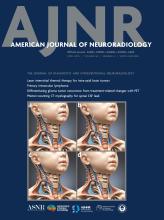This article requires a subscription to view the full text. If you have a subscription you may use the login form below to view the article. Access to this article can also be purchased.
Abstract
BACKGROUND AND PURPOSE: Distal medium vessel occlusions (DMVOs) are estimated to cause acute ischemic stroke in 25%–40% of cases. Prognostic models can inform patient counseling and research by enabling outcome predictions. However, models designed specifically for DMVOs are lacking.
MATERIALS AND METHODS: This retrospective study developed a machine learning model to predict 90-day unfavorable outcome (defined as an mRS score of 3–6) in 164 patients with primary DMVO. A model developed with the TabPFN algorithm used selected clinical, laboratory, imaging, and treatment data with the least absolute shrinkage and selection operator feature selection. Performance was evaluated via 5-repeat 5-fold cross-validation. Model discrimination and calibration were evaluated. SHapley Additive Explanations (SHAP) identified influential features. A Web application deployed the model for individualized predictions.
RESULTS: The model achieved an area under the receiver operating characteristic curve of 0.815 (95% CI, 0.79–0.841) for predicting unfavorable outcome, demonstrating good discrimination, and a Brier score of 0.19 (95% CI, 0.177–0.202), demonstrating good calibration. SHAP analysis ranked admission NIHSS score, premorbid mRS, type of thrombectomy, modified TICI score, and history of malignancy as top predictors. The Web application enables individualized prognostication.
CONCLUSIONS: Our machine learning model demonstrated good discrimination and calibration for predicting 90-day unfavorable outcomes in primary DMVO strokes. This study demonstrates the potential for personalized prognostic counseling and research to support precision medicine in stroke care and recovery.
ABBREVIATIONS:
- AIS
- acute ischemic stroke
- AUPRC
- area under the PRC
- AUROC
- area under the ROC curve
- DMVO
- distal medium vessel occlusion
- ER
- emergency department
- IVT
- IV thrombolysis
- kNN
- k-nearest neighbor
- LASSO
- least absolute shrinkage and selection operator
- mTICI
- modified TICI
- PDP
- partial dependence plot
- PRC
- precision-recall curve
- ROC
- receiver operating characteristic
- SHAP
- SHapley Additive ExPlanations
- ST
- stroke thrombectomy
- © 2025 by American Journal of Neuroradiology












